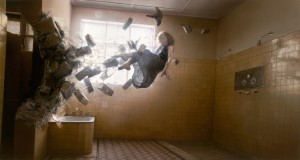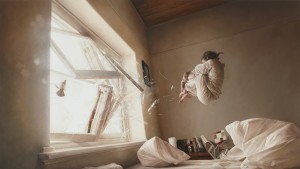Ever since Icarus fell from the sky, we have been in love with the idea of flight. America watched in anticipation and fearful delight as Australian Felix Baumgartner broke the sound barrier and survived freefalling 29 miles back to earth; we cheered when the Curiosity Rover landed on Mars. Paradoxically, we so easily forget the absolute wonder that we are able to defy gravity at a whim as we complain about airfare, bad plane food, and missed connections. Perhaps we feel crushed under the weight of the mundane, the ordinary, or the dread of so many deadlines that loom on the horizon. The work of Jeremy Geddes resides in the ambiguity of these dualities, refusing to give any concrete answers regarding the hyper malaise that our society seems to be succumbing to, and yet it seems to call out for a violent rebirth of creativity. In Pale Memory a violent explosion has blasted out some of the windows, but we can’t quite decipher just where those bodies have been jettisoned from. Are they being blown from the building or falling to earth from the sky? The men are emaciated enough to resemble bird carcasses, hands splayed wide like a chicken feet. The chiaroscuro effects create more riddles as we try to ascertain what is casting such a strong light on only part of the building, while casting the older apartments next to it in darkness. It could be a grotesque alien invasion, one that strips us of all our appurtenances and reduces us to our animal selves (which are strangely fowl-like as opposed to the more predatory beasts).
Begin Again shows a dilapidated building being destroyed, but again it looks less like the typical demolition as the dust and wreckage are being sucked upward. The striped awnings blend into bird wings, as if the building were taking flight, lead by the line of fowl arising from the destruction like a phoenix.The birds do indeed seem larger than the ordinary pigeons that congregate around the tenements housing in the city. They are not crows, not scavengers; they resemble more birds of prey, with their large wingspan and how they seem to be coming to land on the building, perhaps escaping it. Stare at this painting long enough, and the grey-white sky seems to invade the debris like an avalanche, the orange streaks forming the faint outline of a mountain. Is nature now the force invading, not in the guise of a flood, tornado, hurricane, or fire – all the natural disasters we are tragically getting used to seeing – but instead as the very elemental of air ?
In contrast with Begin Again, Acedia presents us with violent innocence. An explosion from the dark bathroom section of an outdated shower room has ejected both a bird and little girl. Their eyes are oddly locked, both shooting backwards, the bird in a strange backwards dive position. We’re given few hints to their narrative, except for the window that divides both girl and bird into light and shadow. This scene might be playing upon a grotesque kind of baptism, for we have the tub, sans water, while she gazes up in wonder at this creature that is certainly no heavenly dove. The title of the piece is actually a 4th century Christian concept that has more of an edge to it than the “deadly sin” of sloth. Kathleen Norris describes acedia as “a toxic, nearly unbearable mix of boredom and restlessness, frantic escapism (including that of workaholism), commitment-phobia and enervating despair.” Geddes’s work catches the essence of this inertia while propelling us into the adventurous unknown, breaking apart the domestic structures we might have made into our own prisons.
A similar theme runs in A Perfect Vacuum, although this time the little girl is getting sucked away from the light, and the flying shards of glass are mere seconds away from cutting her. She is in the wrong position, facing the window when the pillows are right underneath, letting us know that perhaps she had heard something, sensed a disturbance and had gotten up to peer outside. This time the bird is kept outside, the frames of the window forming a barrier to the girl. Is it perhaps too late to help or could the creature’s presence have created the blast? The title suggests the former, but she is caught between the light and shadow, so there is no definite answer as to whether she is being rescued or abducted.
The Jonathan Levine gallery noted that these paintings in the Exhale exhibit were “contrasted by a series of five paintings titled Misèrere (Italian for have mercy), [which featured] a single subject isolated in a solid black plane — alternating birds and a failing Apollo Command Service Module,” and “four paintings with solitary human figures, titled Misère (French for poverty or destitution).” Those haunting, beautiful images add a deeper narrative to these pieces, calling to mind George Elliot’s warning that “if we had a keen vision and feeling of all ordinary human life, it would be like hearing the grass grow and the squirrel’s heart beat, and we should die of that roar which lies on the other side of silence.” Geddes visually depicts that roar in all of its wall-shattering ferocity, even as he directs our gaze to the unbearable paralysis many of us struggle with.
To view more of Jeremy Geddes’ work, please visit his website.
To view the Exhale exhibit, please visit the Jonathan Levine Gallery page.
Works Cited
Eliot, George. Middlemarch
Norris, Kathleen. “Struggling With a ‘Bad Thought.’ ” CNN. Turner Broadcasting System, 6 Apr 2010. Web. Nov 2012.





A very interesting mix of dynamism and stillness and violence and tranquility in these images.
The explanation of the term “acenda” does seem to describe our times very well!
- “acedia”, I mean.